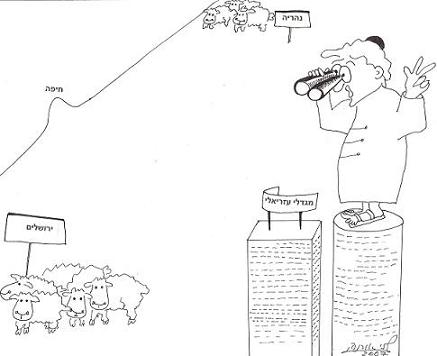
One who owns sheep and cattle must separate one in ten sheep and sacrifice it in the Holy Temple, what the sages call “animal tithes.” It is written, “And concerning the tithe of the herd or of the flock, of whatsoever passes under the rod, the tenth shall be holy to the Lord” (Leviticus 27:32). The sages ruled that these ten sheep, though they belong to a single owner, must also be in one place and within a range of territory customary for grazing, so that the shepherd could count them — within a range of at most 16 kilometers. But if a person owns five sheep in Tel Aviv and another five in Haifa, he has no requirement to tithe the sheep and bring one as sacrifice.
The sages discussed and debated the appropriate distance between sheep which would allow them to be counted together and require tithing.
Thus, for example, they asked: How did the sages arrive at this arbitrary distance of 16 kilometers? Answer: It is learned from the verse in Jeremiah (33:13): “The flocks shall pass again under the hands of he that counts them.” The counting of sheep by the shepherd is only possible, the sages said, when the sheep are no farther apart from each other and from the shepherd than 16 kilometers.
They continued to argue that even if the five sheep are farther than 16 kilometers from the other five sheep, but in the middle there is a lone sheep, this lone sheep gathers them all into a single group for tithing. One of the sages, Rav Ashi, asked: what is the rule if a sheep dog is located between the two groups of sheep? What are the issues under debate? On one hand a sheep dog is trained, and all the shepherd need do is call him and he will come, in contrast to a sheep, which must be approached and taken, so the sheep dog would not be considered to join them into a single group. On the other hand, often the sheep dog is undisciplined and the shepherd must approach him, too.
They continued to discuss a case in which a shepherd has five sheep on the western side of the Jordan River and five sheep on the eastern side. According to one sage, Rabbi Meir, they do not form a single group, even if they are within sight of each other and the shepherd can count them.
Why did he wish to rule so? It is written, “And Jordan was the border of it on the east side” (Joshua 18:20), implying that the Jordan River is a border and sheep on either side of the river cannot be joined into a single group. The scholars asked: if the language of the verse creates borders for the tithing of animals, sheep found on either side of an interior border of the Land of Israel, such as the boundaries of the tribal lands, should also be considered separated by borders for the tithing of animals. The Scriptures do designate these as borders: “And the border went from there to Luz…and described the border…and the border went west to the well of the waters of Niftoach, and the border descended…” Answer: Since the Scriptures included all parts of the Land of Israel within a single border, the internal borders are not considered, as is written: ” this shall be your land with the coasts thereof round about” (Numbers 34:12). If the internal borders are not to be considered, then the Jordan River should also be considered an internal border, for it is part of the Land of Israel. Answer: An internal land border is not considered, but an internal river border is considered a proper border. The scholars added that the question of whether the Jordan River is within the Land of Israel or outside of it is subject to a disagreement amongst the sages — according to one sage, R’ Judah son of Beteira, the Jordan is considered outside, as is written, “For you are crossing the Jordan to the Land of Canaan” (Numbers 33:15), implying that the Jordan is outside the Land of Canaan. According to another sage, R’ Shimon son of Yochai, the Jordan is part of the Land of Israel, as is written, “on this side of the Jordan near Jericho eastward, toward the sunrising” (Numbers 34:15). The Scriptures attached the Jordan to the city of Jericho; just as Jericho is in the Land of Israel, so, too, is the Jordan River part of the Land of Israel.
(Babylonian Talmud, Tractate Bechorot 54b-55a)
